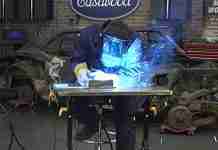In the world of welding, efficiency is key. And when it comes to organizing tools and materials, having ample storage space is essential. That’s where the question arises: how do you add storage to a welding table? Whether you’re a professional welder or a passionate hobbyist, finding clever ways to optimize your workspace can greatly enhance productivity. From built-in drawers to handy shelves, this article explores various techniques and innovative solutions for adding storage to your welding table, ensuring that everything you need is easily accessible and within arm’s reach. So, let’s roll up our sleeves and discover the secrets of maximizing storage in your welding space.
Determining Your Storage Needs
Evaluate your welding equipment and tools
Before adding storage to your welding table, it’s important to evaluate the equipment and tools you have. Take stock of what you currently have and consider how often you use each item. This will help you determine what type of storage solutions you need.
Consider the size and weight of items to be stored
Next, consider the size and weight of the items you will be storing on your welding table. Some tools and equipment may be bulkier and heavier than others, so it’s important to choose storage options that can accommodate the specific needs of each item.
Assess the space available on the welding table
Lastly, assess the amount of space available on your welding table. Take into account the dimensions and layout of the table, as well as any other equipment or items that may already be occupying the space. This will give you a clear idea of how much storage you can feasibly add to your welding table.
Choosing the Right Storage Options
Utilize built-in storage features
One of the most convenient ways to add storage to your welding table is by utilizing its built-in storage features. Assess the existing holes and slots on the table and use brackets and hooks to hang tools and equipment. You can also add magnetic strips for storing metal components, making them easily accessible during welding projects.
Explore external storage solutions
If the built-in storage options on your welding table are insufficient, consider exploring external storage solutions. Attach tool cribs or pegboards to the welding table to maximize vertical space. You can also install additional shelves or cabinets around the table to store larger tools and equipment.
Consider portable storage options
Sometimes, it may be necessary to have storage options that can be easily moved around. In such cases, portable storage options like toolboxes or tool bags can be extremely useful. These allow you to keep your tools organized and readily accessible wherever you need them.
Evaluate the benefits of drawers and cabinets
Drawers and cabinets are excellent storage solutions for welding tables. Building or installing drawers underneath the table provides a discreet and organized space for storing smaller items. Mounting cabinets on the sides or underneath the table offers additional storage capacity, keeping your tools and parts neatly arranged.
Utilize shelves and racks for easy access
Shelves and racks provide easy access to frequently used tools and equipment. Install wall-mounted shelves near your welding table for convenient storage. Welded or detachable racks are also great options for storing larger items like welding masks or clamps. Consider wire or mesh baskets for storing welding accessories, as they allow for quick and easy retrieval.
Built-in Storage Features
Assess the existing holes and slots on the table
When looking to maximize the storage potential of your welding table, start by assessing the existing holes and slots on the table’s surface. These can serve as attachment points for various storage solutions, such as brackets, hooks, and other hardware.
Use brackets and hooks to hang tools and equipment
Brackets and hooks are versatile storage options that can be attached to the holes and slots on your welding table. They provide a convenient way to hang tools and equipment, keeping them within reach during welding projects. You can easily customize the arrangement of these brackets and hooks to suit your specific needs.
Add magnetic strips for storing metal components
Magnetic strips are a simple yet effective addition to your welding table’s built-in storage options. They provide a secure and easily accessible storage solution for metal components like nuts, bolts, and other small parts. By attaching magnetic strips to the surface of your welding table, you can keep these items within arm’s reach while working.
External Storage Solutions
Attach tool cribs or pegboards to the welding table
When the built-in storage features on your welding table are not enough, consider attaching tool cribs or pegboards to the table. Tool cribs provide additional storage space, particularly for larger tools and equipment. Pegboards, on the other hand, offer a versatile solution for hanging tools and accessories. By utilizing these external storage options, you can maximize the available space and keep your welding table organized.
Install additional shelves or cabinets around the table
Another option to consider is installing additional shelves or cabinets around your welding table. These can be attached to the walls or freestanding structures adjacent to the table. By utilizing this external storage solution, you can store larger and less frequently used tools and equipment in a convenient and organized manner.
Utilize tool carts or rolling cabinets for mobile storage
For added mobility and flexibility, consider utilizing tool carts or rolling cabinets as external storage solutions for your welding table. These portable storage options allow you to easily move your tools and supplies around the workshop as needed. With multiple levels and compartments, tool carts and rolling cabinets provide ample storage space for your welding equipment.
Portable Storage Options
Consider using toolboxes or tool bags
Toolboxes and tool bags are excellent portable storage options for welders on the go. Toolboxes come in various sizes and designs, offering compartments and drawers to keep your tools organized. Tool bags, on the other hand, provide a more flexible storage solution, allowing you to carry your tools with ease. Both options are convenient for transporting and storing your welding tools on and off the welding table.
Utilize job boxes or storage chests
Job boxes or storage chests are sturdy and secure portable storage options for welders. These containers are typically made of metal and feature ample storage space for tools, equipment, and other welding accessories. With their lockable design, job boxes and storage chests ensure that your items are safely stored and protected from the elements when not in use.
Explore magnetic trays or bins for small items
Magnetic trays or bins are highly useful for storing small metal items that are commonly used in welding. These trays are equipped with strong magnets, allowing you to keep nuts, bolts, and other small components within easy reach. By having magnetic trays or bins on your welding table, you can minimize the risk of misplacing these small items and save time searching for them during projects.
Drawers and Cabinets
Build or install drawers under the welding table
To maximize the available space and keep your welding table organized, consider building or installing drawers underneath the table. These drawers provide a discreet storage solution for smaller tools, accessories, and consumables. By labeling or compartmentalizing the drawers, you can easily locate the items you need during welding projects.
Mount cabinets on the sides or underneath the table
Mounting cabinets on the sides or underneath the welding table offers additional storage capacity. These cabinets can be customized to accommodate larger tools and equipment. By keeping them within arm’s reach, you can access your welding essentials conveniently and maintain a clutter-free workspace.
Organize tools and parts in labeled containers
When utilizing drawers and cabinets for storage, it’s important to organize your tools and parts effectively. Use labeled containers or dividers to categorize and separate different items. This will make it easier to locate specific tools and parts quickly, saving you valuable time during welding projects.
Shelves and Racks
Install wall-mounted shelves for easy access
Wall-mounted shelves are a practical storage solution for frequently used tools and equipment. By installing shelves near your welding table, you can keep essential items within easy reach. Organize the shelves according to the type of tools or accessories they hold, making it convenient to locate and retrieve items during welding tasks.
Utilize welded or detachable racks for larger items
For bulkier items like welding masks, clamps, or hoses, welded or detachable racks are highly effective storage options. These racks can be custom-built or purchased separately, depending on your needs. Welded racks provide a more permanent solution, while detachable racks offer flexibility for reconfiguration and space optimization.
Consider wire or mesh baskets for storing welding accessories
Wire or mesh baskets are ideal for storing welding accessories such as electrodes, wire spools, or small tools. These baskets allow for easy visibility and access to your welding supplies. By utilizing wire or mesh baskets, you can keep your welding accessories organized and prevent them from cluttering your welding table.
Making Use of Available Space
Optimize vertical space with overhead storage
When dealing with limited space, it’s essential to optimize every inch of your workshop. Overhead storage is an excellent way to make use of available vertical space. Consider installing sturdy shelving or racks on the walls and ceiling of your workspace. This will provide additional storage capacity for items that are less frequently used, keeping them off your welding table and maintaining a clean working area.
Use magnetic strips or hooks on the walls
In addition to maximizing overhead storage, take advantage of the walls in your workshop. Install magnetic strips or hooks to hang frequently used tools and equipment. This will keep them within easy reach while freeing up valuable table space.
Implement a rolling tool cart for additional storage
A rolling tool cart is a versatile storage option that can be moved around your workshop as needed. It provides an additional surface for placing tools and equipment, allowing for easy accessibility during welding projects. With multiple levels or compartments, a rolling tool cart offers ample storage space while keeping your workspace organized.
Create custom storage solutions based on specific needs
Every welding setup is unique, so consider creating custom storage solutions tailored to your specific needs. Whether it’s designing a specialized rack for holding welding rods or building a storage cabinet with compartments for different welding accessories, customizing the storage options will ensure maximum efficiency and organization for your welding table.
Keeping the Table Clean and Organized
Establish a cleaning and maintenance routine
To keep your welding table in optimal condition, establish a regular cleaning and maintenance routine. Wipe down the table surface after each welding project to remove any debris or slag. Inspect the storage areas regularly and remove any unnecessary items or tools that may have accumulated. By keeping the table clean, you can ensure that storage solutions remain functional and free from obstructions.
Label storage areas for easy identification
Whether you’re using built-in storage features, external storage solutions, or portable storage options, labeling is key to maintaining an organized welding table. Clearly label each storage area to identify the contents and ensure that tools and equipment are returned to their designated spots. This will save you time searching for specific items and contribute to a more efficient workflow.
Utilize tool foam or shadow boards to keep tools in place
To prevent tools from rolling around or getting lost in storage, consider using tool foam or shadow boards. These foam inserts or boards can be cut to fit various tool shapes and sizes, creating a secure and organized storage solution. By placing your tools in designated slots or cutouts, you can easily identify missing tools and maintain a tidy workspace.
Regularly assess and declutter the storage space
Over time, it’s natural for storage areas to accumulate clutter and unnecessary items. Regularly assess your storage space and declutter any tools, equipment, or materials that are no longer needed or in use. This will prevent your welding table from becoming overcrowded and make it easier to find and access the items you truly need.
Considerations for Safety
Ensure proper weight distribution to maintain stability
When adding storage to a welding table, it’s crucial to consider the weight distribution to maintain the table’s stability. Distribute the weight evenly across the table to prevent it from tipping or becoming unstable. Be mindful of placing heavier items on lower shelves or in lower drawers to keep the center of gravity low and ensure the stability of the table.
Secure storage solutions to prevent accidents
To ensure safety in the welding area, it’s important to secure all storage solutions properly. Make sure that any shelves, racks, or cabinets are firmly attached to the welding table or surrounding walls to prevent them from tipping or falling. Additionally, ensure that the storage options can withstand the vibrations and movements associated with welding operations.
Keep flammable substances away from welding area
Welding involves the use of heat and sparks, making it crucial to keep flammable substances away from the welding area. When organizing your storage space, ensure that flammable materials such as solvents, oils, or rags are stored in a separate, designated area. This will help minimize the risk of fire hazards and ensure a safe working environment.
Follow safety guidelines while operating and storing equipment
Lastly, it’s important to always follow safety guidelines when operating and storing welding equipment. Familiarize yourself with the manufacturer’s instructions for each tool or piece of equipment and store them accordingly. Keep safety equipment, such as welding helmets and gloves, easily accessible and in good condition. By prioritizing safety in your storage practices, you can create a secure and efficient workspace for your welding projects.
In conclusion, adding storage to a welding table requires careful evaluation of your equipment and tools, as well as consideration of the available space. By utilizing built-in storage features, exploring external solutions, and considering portable options, you can find the right storage solutions for your welding table. Whether it’s utilizing drawers and cabinets, installing shelves and racks, or making use of overhead and wall storage, there are numerous ways to keep your welding table organized and maximize efficiency. It’s important to maintain a clean and organized workspace, implement safety measures, and regularly assess and adjust your storage solutions to meet your evolving needs. With effective storage in place, you can enhance your welding experience and create a safe and efficient environment for your projects.




































